Madgaon – you probably hear this name when you have to come to Goa via train. It is Goa’s main railway station. It is also the commercial hub of Goa and one of the 4 cities of Goa along with Panaji, Vasco, and Mapusa. The town is hardly thought of as a tourist destination for it is little inside the tourist belt of South Goa Beaches. Having said that, any old city has its heritage & charm that can lure tourists. So, we decided to explore Madgaon Heritage and share the heritage walk with you.
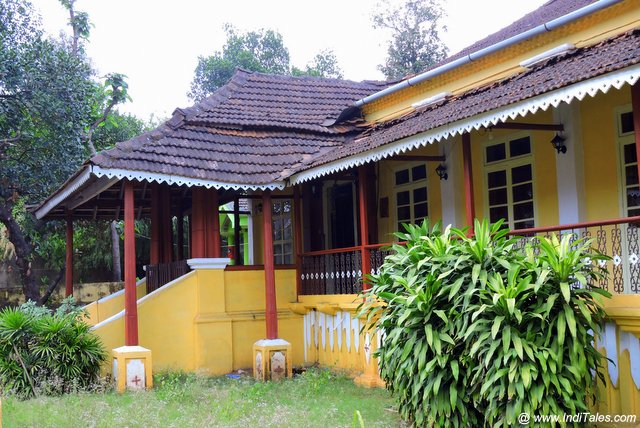
One fine December afternoon, I landed in the town. We intended to start the walk from the municipal garden. But our bus dropped us next to a park, so we made it our first stop for the walk.
We discovered a lot of big and beautiful houses in the town – each with a unique personality, its own color scheme, and its own charm. There are lots of places in Goa where you can see beautiful houses. But in this town, you see them on a single road right next to each other.
You may like to read:
- Places to visit in South Goa – Tourist Attractions
- Dudhsagar Falls – Trip to the most beautiful Waterfall in India
Madgaon Heritage Walk
Wear your walking shoes and let us start walking in the commercial town of South Goa:
Lohiya Garden

This is a small garden with the statue of Ram Manohar Lohiya standing on a platform with his hand pointing in the manner of ‘Moving Ahead’. There was a function going on, so we took a quick round of this small garden and moved toward our intended starting point for the Madgaon Heritage Walk.
Municipal Building
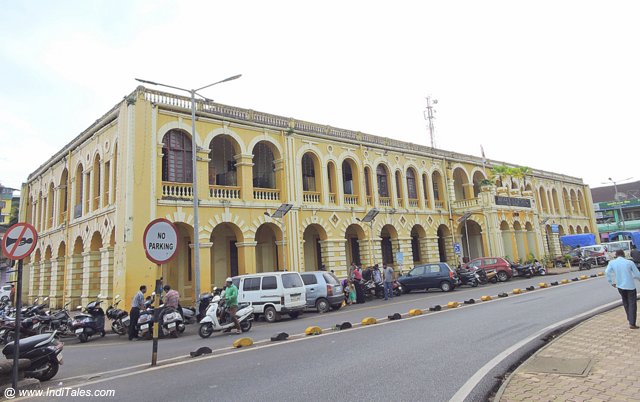
The Municipal Building in Madgaon is a more than 100 years old colonial-era building in pale yellow. Walk through its arched corridors to appreciate its neo-classical architecture. Go around and you would see a library behind it.
Municipal Gardens

Bang Opposite the Municipal building is the Municipal Gardens where you would see tons of people walking around or sitting around. If it is siesta time, you would find people sleeping too in the garden. It is a small garden with busts of many prominent Goans standing here. Unfortunately, most of the plaques are illegible. There are benches around trees to sit on. We walked leisurely admiring the people more than the garden. Exchanged some smiles with the street vendors, and crossed a closed garden that has the name Aga Khan mentioned on board.

Across the road, we met this lovely stainless steel sculpture by Goan Artist Subodh Kerkar celebrating the women workers of Goa.

The post office in its red and white color housed in what looks like an old house looks charming.
Houses of Abade Faria Road – Madgaon Heritage
We took the road on the left of the Post Office – the Abade Faria road. Our Madgaon heritage walk was essentially a walk on this road. We were surprised to find so many heritage houses and commercial buildings here that it took 3 hours to cover 600 meters of this road. Here are some of the things that we discovered:
Carotronics Building
As soon as we started walking we found an old printing press that no longer functions. But the board still stands.

Bang opposite the Press was the Carotronics building – an erstwhile office of the company that then dealt in all kinds of electronic equipment like cameras, projectors, electronic typewriters, etc. You just cannot miss the sharply arched doors on the first floor against a turquoise wall. The paint has fallen off in so many places that it gives the impression of a print on the wall. We spoke to a gentleman at the only open door on the ground floor before braving to go up.
Yes, it needed some courage to take the wooden steps. Then walk on the wooden corridor that we had no idea if it can take our weight. We tip-toed to reach the main door when someone stepped out and we could breathe easily. The gentleman showed us the house – its kitchen, rooms, and backyard. It belongs to a business family. The first room still has its grandeur intact. There is stucco work around the room in green color. Even in its dilapidated state, it looked nice. Not fine work, but work that stands out.
Walking around the house, which is only half of the original house. I wondered how it would be to live in these wooden houses.
Confidant Library
You would see a lovely pale pink building with shell windows on the first floor in the corner. Take a right and a few meters ahead you would find Confidant Library in green color. This is a small but very old-style library in the lane next to the Carotronics building. It is a bookshop, a text bookshop, a lending library, and, hold your breath – a funeral service.
Confidant Library is a glimpse into how the old Goan libraries used to be.
We came back on AF Road and walked past some bright yellow houses on our left and a small blue one on our right. We stopped by a temporary shop selling Christmas items.
Colorful Goan Houses – Madgaon Heritage
Here onwards it was our time to be mesmerized by the grand houses of Goa.
The first house we spotted was a closed yellow house with Red Balcao and Red Sopa on the left. How we wished we could take it over and convert it into a cultural open space.

The Red House
Red House – Next was a big red house on the left. This is a corporate office now. Which means it is well-maintained and used. We stepped inside its door that was open. We were greeted by the wide staircase that divided itself into two halfway through. Steps were made of solid stone and the railing was in delicately carved wood. It seems like it would have been a public building of some kind. But I could not gather any information.
Interestingly this house has two smaller gates on both sides that now lead to the parking lot. But, may have been the gardens once upon a time. There are glass-paneled windows in dark wood. The upper floor ones have hanging balconies resting on small white brackets.
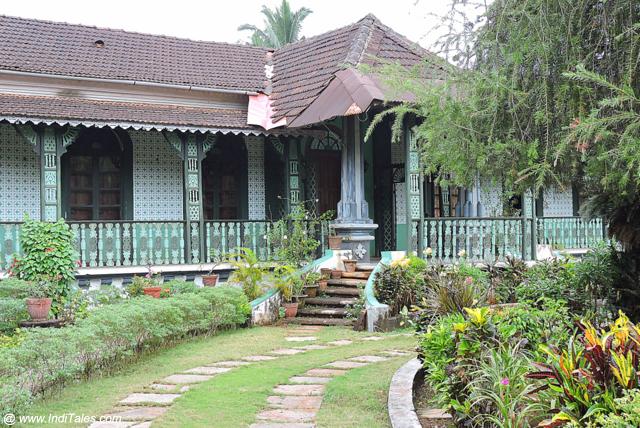
The Green & Blue House
Green & Blue House – This is a unique single story with a huge garden in front. The corridor running in front of the house and the porch has a filigree-like delicate design on both the pillars and the brackets. The walls have Azulejos tiles. The Aquamarine tiles look lovely with the green wooden frames around them.
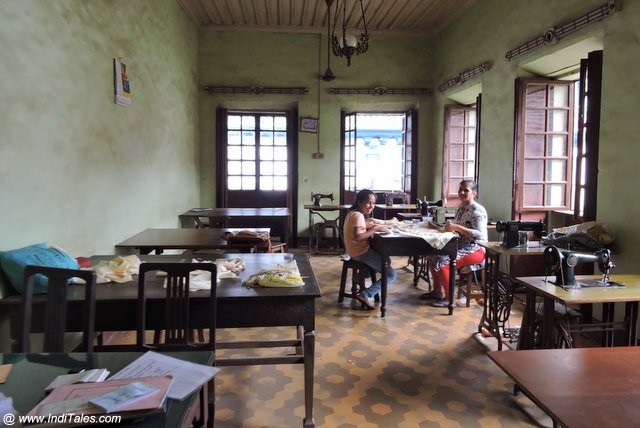
Instituto De Artes Femininas – Housed in a room of another beautiful house, this is an old tailoring school. We were gracefully invited inside. Mira Coutinho, the instructor told us that she runs five batches of tailoring every day. They also teach paper flower making and machine embroidery. What was fascinating here was the old sewing machines that were still in use. Mira could tell us where each machine came from and how it is used. Do step in and see this lovely government-approved school if you go on this Madgaon Heritage Walk.
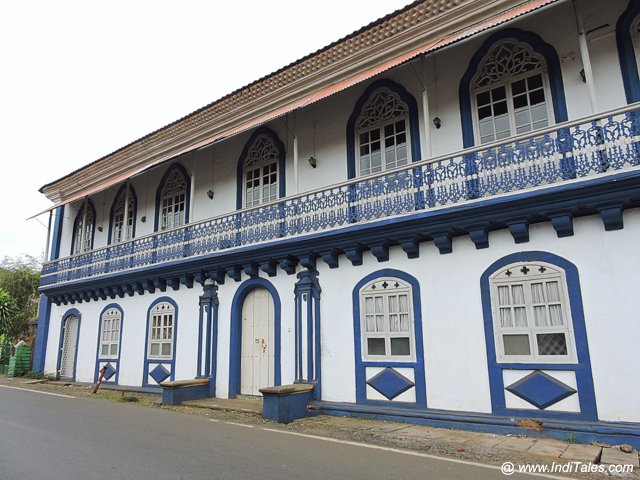
The Blue & White House
Blue & White House – Bang opposite the institute is this majestic house in White and Blue. I wonder if it was originally white? During the Portuguese era in Goa, houses were not allowed to use the white color. As that was reserved for the churches. Or, did the bit of Blue outline allowed this house to circumvent that rule? The special architectural feature of this house is its long-running hanging balcony that runs across the length of the house. Two small sit-outs on either side of the main gate are interesting.

The Red & Green House
Red & Green House – This is a small house with red walls and green parapet railings. The windows have a white dot on the cross-section of panels. A simple design element lends a certain elegance to the house.
Here and there we saw houses with shell windows. Sometimes part of them is replaced with glad. There are big and small houses in all possible colors and color combinations.
The Pink House
Pink House – Pass by the red building of Franciscan Hospitaller Sisters that now houses a nursery to reach this pink house with an intricate railing outside it. I wonder what purpose it served as the space behind it is very narrow. I cannot think of anything but ornamentation. It does lend elegance to the otherwise plain house with tall windows. There is a moat-like opening outside the house. Then another small wall with floral Azulejos on top as if compensating for the absent garden.
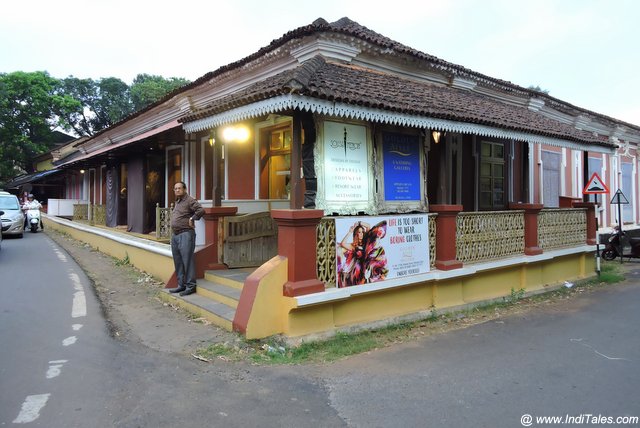
Heritage House Turned Boutique Store – This is a large house that is now a fashion boutique. We walked around the boutique and I wondered how they managed to renovate the house so well.
Yellow House Celebrating Glass – A pale yellow house has a window full of small glasses again decorated with a finely carved railing. Looks like this house reminds us of the times when the glass started replacing shells in Goan windows.
Temples of Margao
After relishing the heritage houses, we met two temples on the same road.
Ram Temple – This is a small temple dedicated to Ram, Laxman, and Sita. It has Ram Stutis written on the walls.
Damodar Sal

The Damodar Sal is a small private temple that is open to the public. This is where Swami Vivekananda stayed when he visited Goa in October 1892. It is dedicated to the Damodar Avatar of Shiva. The one-room temple has large Tanjore paintings of various Hindu Deities like Ram, Laxman, Sita, Hanuman, and Tirupati Balaji.
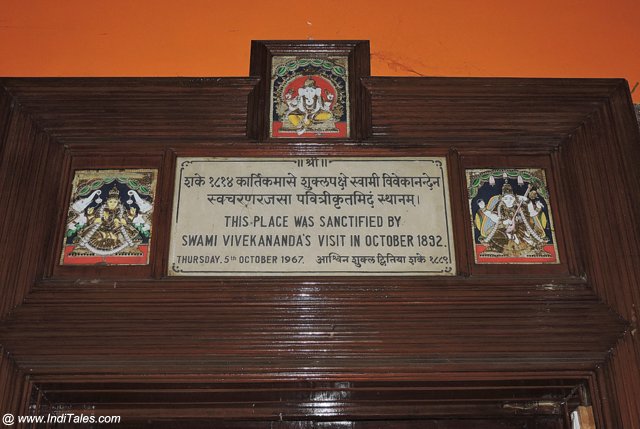
It is believed that the deity mounts his horse and takes the round of the town every Monday – the day of the Shiva. Shivaratri attracts a lot of crowds to Damodar Sal. It was at one of the temples before the deity was moved to this privately-owned hall of a wealthy Hindu family. It has been here for 250 years or so.
What is interesting is that it is the cultural heritage of Madgaon. Sal comes from Shala which means a hall. This was the town hall where community disputes were settled in the presence of the presiding deity of the community.
Remember Madgaon was called Mathagram in ancient times for the nine Mathas or the spiritual schools that used to be here a long time back in history.
At the end of Abade Faria Road is the old market. Take a right turn from here to reach the Margao Church which it is said was built on the temple tank of an ancient temple.
It took us nearly 3 hours to cover just one road. We had to let go of visiting the famous town market.
Heritage Walk
Madgaon heritage walk left us overwhelmed with the grandeur and scale of houses here. They tell you about the affluent people of Goa. In other places, some of these houses would be called palaces or mansions. I wonder how many people lived there. And how many were employed there. I wonder how it would be to live in them.
I know I need to go back to explore the famous market of the town. But for now, I am enjoying the gorgeous houses of the town.






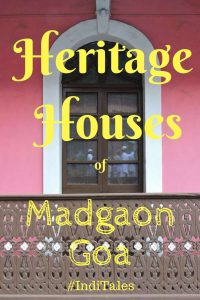








O wow…such lovely architectural buildings…I particularly loved the Green and Red house!! The filigree work is indeed stunning. Glad to get a glimpse of my favourite aspect of any place which is Architecture.
A week long trip to Goa may just be sufficient to explore all this along with a couple of beaches, isn’t it, Ma’am? Of course, I do know that this may not do justice to a place, still, as a tourist I would like to know 🙂
Yes, a week-long trip can cover a lot of Goa. Let me know when you plan to come, I will help you plan your itinerary.
Nice article. I really enjoyed reading and knowing about madgaon and your pic is really very beautiful.
Thank you, Nitya. We at IndiTales try to bring you stories that help you know a place better.
I have been to Goa twice but reading your Goa posts always makes me feel as if I have hardly seen anything except the beaches. There is so much to explore. Next time I head to Goa, I am going to take this heritage walk for sure… and will meet you too 🙂
Neha – Goa like most places in India has so much to offer to a curious traveler. Hinterlands of Goa are as beautiful as its beaches. Look forward to meeting you in Goa.
Lovely post..
Thank you.
These are all familiar lanes and houses. Thank you for bringing them to life through your post, Anuradha 🙂
So happy that you could go down the memory lane with this IndiTales post, Elita.
Fascinating! Thank you for the wonderful photographs and insights, now definitely on my must visit list!
Have fun in Madgaon 🙂
Hi Anu,
Nice article as always. That sculpture of Goan woman looks eccentrically beautiful – great work of art. You could have written bit more about its artist.
Sherab – Subodh Kerkar is a very famous artist and the founder of Museum of Goa. Just Google more about him and his contemporary work on Goa & Goan heritage.
Thanks for the tip. Now I know bit more about him..:D
It seems Goa is a very artistic destination as well. Pleasure to read and will love to visit one day 🙂
Nafisa, Goa is the favorite beach destination of goa with lot of heritage.
Though we drove around Goa we mainly hung out in Panaji. So we really seemed to miss out on Madgaon. I guess it gives me a major reason to return to this beautiful south west section of India and explore more than just the beach areas.
Eric, yes, Goa and in fact, every part of India has so many layers that you can keep exploring it forever.
Awesome blogpost! Thanks for sharing. Like it very much 🙂 On my next India bucket list 🙂
This looks like a super interesting place to explore, I love the steel sculpture
Margao has always been an interesting city. It has a lot of the Portuguese flair which I so love about Goa. In a way it’s like traveling to Brazil, just that you are still in Goa. The Portuguese houses are in great shape too and well taken care of, not like in Mapusa for example. I had no idea about the Instituto De Artes Femininas, that is quite an exciting find and I am happy to know that these institutions still exist. I had heard that such a place existed in Nerul (north Goa) a few years ago. They made beautiful banana fiber baskets. When we went there people were reluctant to speak to us and made us understand that we should leave and according to them they had closed and shifted but they wouldn’t say where. I think preserving the art of making crochet for example (as is a local art here) should be paramount to keep the cultural identity.
Helene – I refrain from calling them Portuguese houses – to me they are Goan houses that do have some Portuguese influence. Crochet too is a pretty much a pan Indian thing – I do not think it is specific to Goa or if it has Goan roots. People at the institute were really welcoming and it was such a pleasant experience to meet them.
Madgaon reminds me of Georgetown in Penang, with all its artwork and beautiful, unique houses. I’m wondering if the architecture was inspired by the same…traders? I have yet to explore India myself, but when I do, Goa is certainly on my itinerary. I’ll be sure to keep this place in mind when I visit.
Skye – Madgaon, and Goa were under Portuguese rule for more than 400 years, so you do see their imprint on everything here.The core style is local but the influence is colonial. Goa is India’s hottest tourist destination.
Having ancestors from Goa meant visiting once a year especially when I was in school. I never really realised how pretty and distinctive the architecture is till I grew up. Your post really brought back so many memories. I usually don’t stay in Madgaon, but next time I go I will follow your heritage walk and explore the architecture in Madgaon. Love the red & green and the white & blue houses the most.
Shruti – we always need an outsider’s eye to admire our own heritage. Next time you are in Goa, do visit some of the heritage walks of Goa we have documented.
Goa is love and we can go there N number of times. In particular, Goa always reminds me of beaches. But now after reading your post, I have a feeling I haven’t seen anything in Gia. The colorful houses are so beautiful and your pictures have given them life. Great post and pictures.
There really are some beautiful houses here! And buildings too – the Municipal Building is quite beautiful, and I love the post office – so charming! You really can tell that there’s a lot of history here, every building / house seems like it has a colorful past, and a story to tell. Very cool that the heritage walk not only includes the grand architecture of the homes, but also has temples dotted on the same road 🙂
Megan – Most places in India have such layered history that you are hardly disappointed when you walk through an old lane. Madgaon has some of the most beautiful houses in Goa and yes each of them tells the tales of the global it was once with all the influences that we can see in its architecture.
So love the architecture, especially that near bright yellow municipal building. And that greenhouse with filigree decor. All so lovely!
Carol – I wonder where we lost our creative streak for the cookie cutter buildings of the current age.
I think the green and blue House is my favorite, that and Goan Woman in Stainless Steel by Subodh Kerkar. Thank you for bringing us along on such an interesting journey.
You know, even though I am aware of Subodh Kerkar’s work – this was a pleasant discovery on the Madgaon Heritage Walk.
This has nothing to do with the post but I want to say I love the logo for the blog…
Ok heard of Goa but everything else…total mystery.
The architecture here in Madgaon is very interesting…I really like the Green House with Filigree Pillars and Brackets. That shade of green is beautiful. Actually so is Majestic Blue & White House. I really enjoy these heritage walks as they always provide a fantastic story backdrop to the area.
Thank you so much, Christopher. We wanted a logo that reflects the folk art tradition of India. We love walking around the old inhabited areas wherever we go. Goa is home but we have done walking trails in many places in India and around. They always lead to many surprising discoveries.
This is too good! I am a big fan of walking tours and always say that you discover the best of a city by walking its streets. I have been to Madgaon before but only as a springboard to other places. Looks I must make an exclusive visit just to explore this “Non-touristy” city. 🙂
Being in Mumbai it is just a overnight train away!
Nisha Ji – Come over any time, there are a lot of walking space in Goa 🙂
Nice article. I really enjoyed reading and knowing MADGAON HERITAGE WALK
Thank you.
Never knew that there are many beautiful places in India aside from the Taj Mahal. Hehe.. Hope to visit India someday.
Luis – India is infinite – you can spend many lifetimes exploring it. I hope travelers come and explore it beyond the Taj Mahal.
Dear Anuradha,
I’m a Goan who spent my formative years in Margao. The town is a bit dreary these days, but a few decades ago it was a rather lively place to be. Those sprawling houses – I lived in one – are indeed Goan houses as you say, but their particular style of architecture is referred to as “Indo-Portuguese.” I know the names and history of every house you photographed on Rua Abade Faria. By the way, no Goan would spell it as “Madgaon”, although that is the spelling you see at the railway station and some government offices. For us, it’s just “Margao”, with a nasal inflection over the last two letters. If you say it in our local language Konkani, it sounds more like “Modgao.” Cheers, Sam
Sam – a lot of Indian city names got frozen when a railway station came up there. I chose to write Madgaon instead of Margao because one it is the official name and second it is what people come searching for. I wish I could go with you and listen to the stories of each of those houses. In fact, I postponed this walk for a long time in search of someone who can take me along, but when I could not find anyone – I just decided to go on my own.
Not sure if that’s right. It makes more sense to use the name that’s actually used by the people. I’ve never heard anyone using the name “Madgaon.” Just like nobody says “Panaji” although that is the official name. It’s “Panjim” in English and “Ponnje” in Konkani.
Have got down so many times at Madgao but never cared to explore this city. Thank you for this wonderful post 🙂
Next time you are in Madgaon, do take a walk around the city – you would love it even more.
I have visited many time goa but never know about more Madgaon but after reading your post I got many new things about Madgoan/
are they named by their colours or are you calling them by colors?
And one more question arises in my mind is why do each building is different in colour?
do they convey something? I am excited to know this.